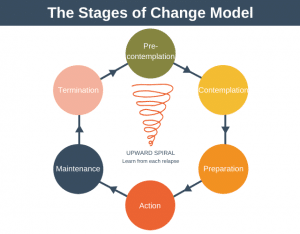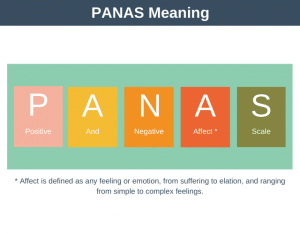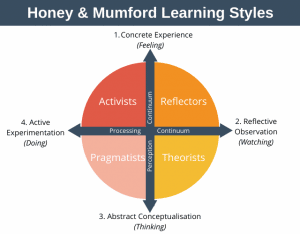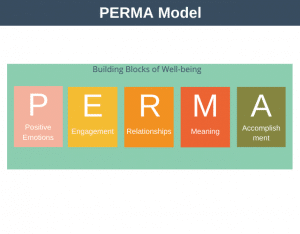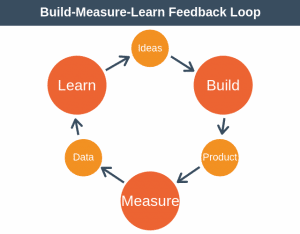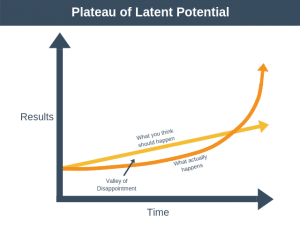Cognitive restructuring is a technique that can help you identify and change negative thoughts that are holding you back.
Imagine as a child you performed poorly in a math exam. You showed your test results to your parents who in turn, suggested that maybe you’re just not suited to math.
The next time you took a math exam, you had a niggling doubt in your head that perhaps you’re no good at maths. Sure enough, you didn’t perform well in that test either. Upon seeing your results this time your parents tell you that you’re not a math person.
Over time you start to believe that you’re no good at math. Because you know you’re no good at math you start to avoid it if at all possible.
Later, in your adult life, you know having good math skills can help your career, but you avoid improving your math skills. Why? Because you think, “I’ll never be good at math, so what’s the point.”, and similar thoughts.
Henry Ford said, “Whether you believe you can or you can’t, you’re usually right.”
If you have a fundamental belief that you can’t do something, then you’re very unlikely to be able to do it. If this belief is stopping you from achieving all you want in life, then it’s a belief that isn’t serving you.
By using Cognitive Restructuring, it is possible to change your negative beliefs by changing your thoughts.
Cognitive restructuring is a technique that teaches you to identify and reframe the thoughts that are holding you back.
Instead of simply accepting negative thoughts as fact, such as “I’ll never be good a math”, cognitive restructuring helps you start to assess them rationally. When you accurately reflect on these negative thoughts, sometimes called automatic negative thoughts, you can discover that they are irrational and not a true reflection of reality.
Cognitive Restructuring Example
Imagine you are on a diet and trying to lose weight. You watch what you eat all week, only consuming diet-friendly foods.
At the end of the week, you weigh yourself and discover that your half a pound heavier than last week.
At this point, there are two thoughts you could potentially have: a functional thought or a dysfunctional thought. Each type of thought will have different outcomes or consequences.
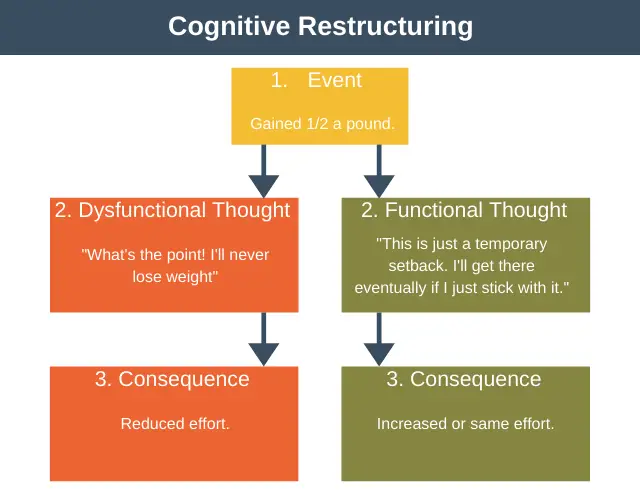
A functional thought would be something like, “This is just a temporary setback. I’ll get there eventually if I just stick with it.” A dysfunctional thought would be something like, “What’s the point, I’ll never lose weight.”
If you experience a functional thought then you’re likely to not dwell on your temporary setback, and get on with your day and diet. If you experience a dysfunctional thought then you’re likely to be upset, feel bad, and even binge eat as you can’t see the point in dieting.
The purpose of cognitive restructuring is to intercept these negative dysfunctional thoughts and replace them with more realistic thoughts so you can achieve your goals.
So, the next time you catch yourself thinking, “what’s the point in dieting”, you catch the thought immediately and tell yourself that, “actually, there’s lots of point in dieting. This temporary setback won’t stop me.” In this way, you stop your negative thoughts in their tracks and keep on the path towards your goal of losing weight.
Events will happen in our lives, it is how we respond to them that matters.
How to use Cognitive Restructuring
Just like building any habit, to use cognitive restructuring effectively requires practice. Negative beliefs can be deeply ingrained and it takes consistent practice and patience to replace them with more empowering beliefs.
It is important to undertake cognitive restructuring with an open mind. Once you start to notice the thoughts that pop into your head you might be surprised by how many of them are negative.
Negative thoughts can often leave us feeling overwhelmed, anxious, and overly emotional. If you find yourself feeling this way then give yourself some time to calm down and relax before you begin the process. This will enable you to examine your thoughts more realistically.
Step 1: Notice the Automatic Thoughts
Automatic thoughts happen spontaneously, almost as though they appear from nowhere. They can be in the form of a type of self-talk, or image.
Examples of common negative thoughts include:
- “I’m stupid; I forgot my house keys again.”
- “No one understands me.”
- “Something has to change.”
- “I’ve let people down.”
- “It’s just not worth it.”
- “I’m an idiot!”
- “I’m no good.”
- “I don’t deserve to be successful.”
When these thoughts come, it is best to get them out of your mind and write them down onto some paper. This way, you can see the thoughts clearly as they are.
Once you’ve started to catch your negative thoughts as they happen you might be surprised, or even shocked, by how many you have. Don’t be alarmed, this is perfectly normal.
Step 2: Was there a Trigger?
If your negative thought was caused by a specific situation then write the situation down. Knowing what situations trigger your negative thoughts can help you better prepare to handle similar situations in the future.
For example, many people experience negative thoughts after receiving negative feedback from their boss. Some people might even experience a negative thought after every meeting with their boss, regardless of the content of the meeting.
Step 3: How do you Feel?
In this step, we score how anxious or emotional our negative thought is making us feel. We do so on a scale of 1 to 10. A score of 1 means the negative thought is having no impact on us. A score of 10 means we are overcome with anxiety and barely able to function or think straight.
For example, if you are a person who is more comfortable spending time by themselves, you might feel threatened when asked to participate at work in a large group. During the meeting, you are asked for an opinion, and this triggers the negative thought, “I’m probably going to get this wrong.” You may worry that you could make a mistake in front of the crowd.
This thought that you might get something wrong in front of the group may trigger a strong emotional feeling of anxiety.
Your job in this step is to rate the intensity of that feeling. For our example, you score the feeling a 7 out of 10. You feel as though the intensity of the feeling is affecting your performance in front of the group. However, you are not 100% sure whether others in the group have noticed.
Once you have used your awareness to record the situational trigger and your thoughts and feelings, you can analyze what is going on. This next step helps you to understand the reality behind your reactions and behavior.
Step 4: Analyze the Evidence
Suppose that your boss gives you some feedback and this triggered the negative thought, “I’m stupid!” Our aim in this step is to objectively see if it is really true that we are stupid 100% of the time.
In this step, we identify the following evidence supporting the fact:
- My boss gave me some negative feedback today.
We also find the following evidence contradicting our negative thought:
- My boss has given me lots of positive feedback previously.
- They wouldn’t have employed me if they thought I was stupid.
- I wouldn’t have passed my professional exams if I was really that stupid.
- I received praise from one of my colleagues only yesterday.
As you can see, through inquiry, we’re starting to build up a picture of whether the negative thought is actually true all of the time. In this case, it clearly isn’t true all of the time. In fact, there are many more occasions where it isn’t true and only one occasion where it might be true.
Hopefully, you might be beginning to realize that you had believed an irrational thought that was not true. With this increased awareness, you can now take the impactful next step by choosing to reframe the negative thoughts.
Step 5: Reframe your Thoughts
In this step, we come up with an alternative thought to replace our negative thought. This will help you to develop a more realistic way of seeing the situation.
Looking again at the example above, you might choose to replace the negative thought, “I’m stupid!”, with a more realistic thought, such as, “My boss is giving me some constructive feedback, I should use this as an opportunity to improve.”
Going forward, every time you find the thought “I’m stupid!” popping into your head after the conversation with your boss, you can replace it immediately with the more realistic thought.
Step 6: How do you Feel Now?
The final step of the process is to again score the intensity of your feeling on a scale of 1 to 10. Only this time you score how anxious the more realistic thought makes you feel.
You should notice that the more realistic thought makes you feel far less anxious than your negative thought did. This will reduce the intensity of negative emotions and allow you to see the impact the change in the way you see your thoughts is having.
Improving mental habits requires consistent work. When changing physical habits, it is easier to adapt because you can see the impact change is having. When you are exercising regularly, you can notice you can run further. Sometimes it is not so easy to change your thoughts – the cognitive restructuring process can help you build some consistency.
When you consistently practice the technique, you will notice a reduction in the intensity of the feelings you have when a situation triggers strong emotions. This positive achievement helps you recognize the change that cognitive restructuring provides, and so supports the shift in your thinking.
Summary
Cognitive restructuring is a technique for changing negative or irrational thought patterns.
Using the technique allows you to put your thoughts on trial and take control of them, keeping the ones that serve you and replacing the ones that don’t. This is important for personal development, as it can keep you on track towards your goals.
Training your mind to use cognitive restructuring allows you to experience the world and your relationships in a more balanced and rational way.
